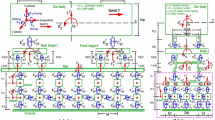Summary
An algorithm is presented which can be used for the investigation of a large variety of train-track models. These models only have to fulfil the requirements of linearity and periodicity with respect to the track length direction. A steady-state solution is obtained for a vehicle moving on a tangent track with constant velocity. The algorithm itself can be split into three modules: one for the whole train-track system, one for the track, and one for a single rail support. These modules and their interfaces are described in detail. The article demonstrates the applicability of the algorithm by means of four examples. The first example shows the influence of the sleeper elasticity on the sleeper motion. The second one illustrates the effect of an advanced subsoil model on the wheel/rail contact force. Subsequently, as a further example, the compliance frequency-response functions of a ballasted track and a rigid track are compared. The last example deals with the sleeper passing excitation. Here, it is shown that even in the case of resonance, the wheel/rail contact-force fluctuations remain below ten percent of the static value.
Similar content being viewed by others
Author information
Authors and Affiliations
Additional information
Received 17 January 2000; accepted for publication 18 August 2000
Rights and permissions
About this article
Cite this article
Kruse, H., Popp, K. A modular algorithm for linear, periodic train-track models. Archive of Applied Mechanics 71, 473–486 (2001). https://doi.org/10.1007/s004190000151
Issue Date:
DOI: https://doi.org/10.1007/s004190000151




